Back-to-school season is one of the busiest and most important seasons for retailers—it’s the second-biggest event on the retail calendar, after the winter holidays.
The National Retail Federation (NRF) and Deloitte Consumer Industry Center recently released their 2024 back-to-school retail trend reports. They anticipate back-to-school spending to remain flat, with parents choosing value over brand loyalty amid consistent price increases.
The NRF forecasts back-to-school spending to reach $39 billion, down from last year’s $41 billion. Family spending per child in elementary and high school is expected to average around $874.68 per child, approximately $15 less than last year’s $890.07.
So how do you get sales from families conscious of spending and their budgets? We list back-to-school marketing ideas and tips below, based on the retail trends we gathered.
1. Start Early
According to the NRF, more than half (55%) of consumers started shopping for back-to-school items in early July this year, on par with last year and consistent with the trend of earlier shopping for major spending events.
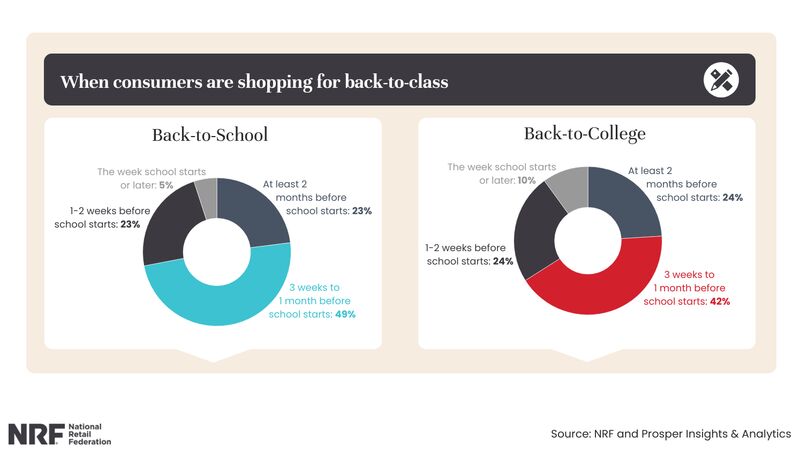
(Source: NRF)
Promote Early
Our retail marketing calendar recommends marketing for seasonal events one to three months in advance. So, plan your promotions and start marketing campaigns earlier, like around June, if you want to stay ahead of the game.
If you haven’t done anything yet and it’s already past the recommended promotion stage, don’t get discouraged. The majority (86%) of consumers still have at least half of their shopping remaining. Nearly half (45%) of families have not received their school lists, with the same majority (45%) waiting for the best deals.
Plan Ahead
The key to a successful back-to-school shopping season is preparation, especially when it comes to your inventory.
The demand for school-related items (electronics and gadgets, clothing and accessories, school supplies, and dorm furniture) will be high during the back-to-school shopping season. This means you need to determine which items are in demand and ensure your inventory levels can meet the increase in demand.
Inventory management is crucial. If you understock, there is a high risk of missing out on sales. If you overstock, you will have excess inventory that’s hard to sell.
Some action items to consider:
- Check your store’s purchase history from last season. Make sure your merchandise is on point to prepare for this and compete with big retailers like Amazon. Using your point of sale (POS) or retail management system, you can look at your store history to check which items were bestsellers from last year’s back-to-school season.
- Compare competitor pricing. Check your products’ price competitiveness to see how other retailers are pricing the same products you sell to give you an idea of what deals to offer. Use the data to map out your pricing and merchandising strategy. Learn how to price products strategically; you can base your decision on common pricing strategies, too.
- Monitor rising retail trends. Track which items or promotions are trending so you can adapt. In general, it is always a good idea to stay abreast with retail trends.
- Know local school requirements. Get accurate school supplies, athletic gear, and uniform lists from your area school districts, and make your stock purchases accordingly. Nothing is more frustrating for shoppers or store owners than processing returns because something didn’t match a school requirement. So, stick to the list to ensure your products get sold.
- Stock up on best-selling essentials. Don’t be afraid to stock up on basic and other fast-moving essentials when purchasing back-to-school stock. However, be wary of splurging on specialty or seasonal goods. Learn how to prevent stockouts. I recommend using a POS inventory system that can help you manage an efficient retail inventory.
2. Run Special Discounts & Events
The main reason consumers are shopping early is to stretch their budget and take advantage of deals. This isn’t surprising—while inflation has leveled a bit, consumers are still feeling the pinch of price increases.
This year, 66% of planned spending is expected to occur by the end of July, up from 59% in 2023. More than half of respondents (59%) from the Deloitte study say the best deals occur early in the season.

(Source: NRF)
Announce your promotions and sale events early to garner attention online so that shoppers can plan. Target back-to-school shoppers by giving them special discounts.
Here are some specific back-to-school promotions to help you get started:
- Bundle deals (like back-to-school kits you can create depending on your store’s offering)
- Coupons and promo codes
- Contests and giveaways
- Sale events, pop-up shops
- Offer free shipping for back-to-school items. Consumers expect free shipping, and sellers who offer it see higher sales and fewer dropped carts. If you don’t already provide free shipping, try offering it for a minimum purchase—$32 is the average order amount consumers are willing to spend to get free shipping. This encourages buyers to increase small orders for free shipping, and you can market it in your back-to-school promotions.

Take a look at this retail brand’s announcement of its sales and promos on its Instagram account.
3. Highlight Product Value
The common trend in the savings-focused shift in shopping behavior shows that more consumers are not loyal to brand products. Consumers surveyed in the mentioned Deloitte study show that 50% are shifting to private label and shopping around more retail formats to find the best deals (4.7 average formats vs 3.9 In 2023).
Here are some marketing strategies you can use to highlight product value:
Focus on Your Product’s Importance for Back-to-School
For example, if you are in the food industry, you can put together a resource on how to cook snacks for school children in less than 30 minutes using the products you offer. Meanwhile, if you provide furniture, consider creating a video tutorial on assembling furniture or showcasing how a dorm room looks with your furniture.
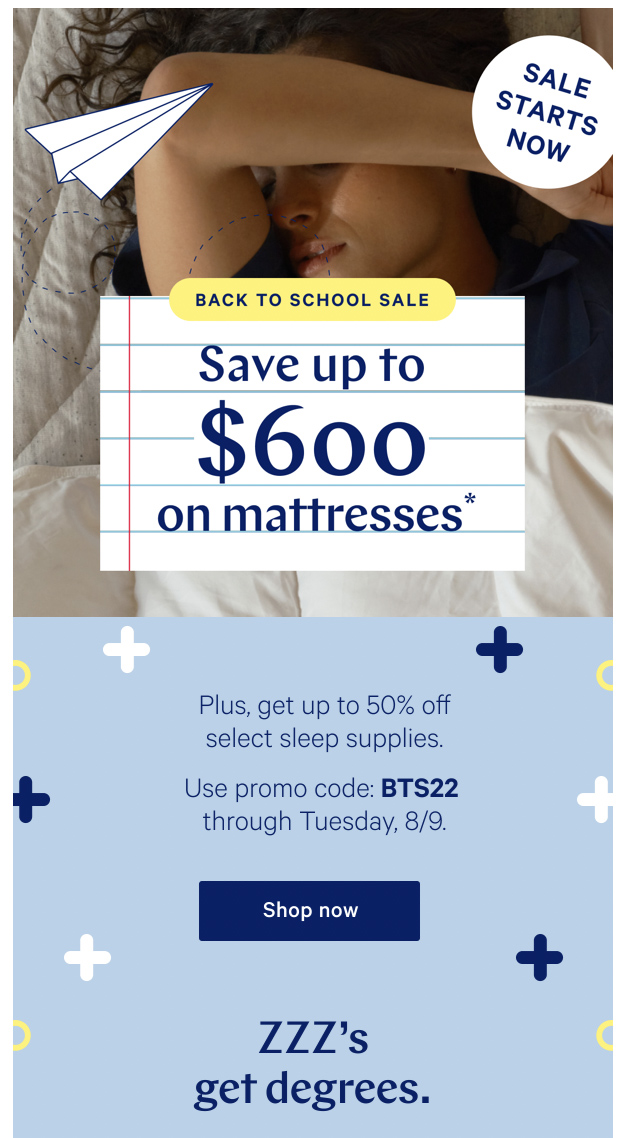
Though mattresses aren’t a typical back-to-school item, mattress brand Casper connects sleep to studying in its back-to-school advertisement.
Be Deliberate with Product Value Messaging
You are already in a good place since customers do not place loyalty high up in their priorities anymore. However, placing messaging cues in your promotions is key to cinching sales.
For example, purchases in circularity programs are growing—4 in 10 parents (across income groups) are expected to purchase a used or refurbished item this season. Right now, only 2 in 10 retailers offer used assortments in their stores.
Consider expanding your circular assortments and place messaging around sustainability and credibility. It is better to buy from a trusted source than go with popular peer-to-peer marketplaces.
Amp Up Social Media Presence & Partner with Influencers
Exposure to social media and influencers has downplayed the importance of brands. Social media users are less focused on brand names—59% are likely to buy private labels over name brands. Two in three follow their preferred retailers on social channels, too.
Partnering with influencers, along with establishing a solid and consistent social media presence, will certainly place value on your products, increase name recall for your brand, and increase sales.
Read our free resources:
- Ultimate Guide to Influencer Marketing: What It Is & How It Works
- Influencer Marketing Campaigns for Small Business Promotion
- Social Media Marketing for Small Business: Guide + Template
4. Invest in Loyalty
Both NRF and Deloitte confirm that consumers now value lower prices over brand loyalty because of the extended effects of inflation. Parents will economize and trade off, showing frugal behavior and low loyalty.
However, there is still a way to capture sales. It is the best time to lean on your loyalty benefits. Create consistent online and in-store shopping experiences to encourage loyal behavior.
Give bigger customer discounts and pre-sales offerings for those under your loyalty program. Don’t have a loyalty program yet? Learn how to create a loyalty program and find creative customer loyalty program ideas.
Offer incentives early on in the season and extend redemption beyond the season. This will encourage them to spend all season as long as they get lower prices (or more benefits). Loyal back-to-school shoppers spend 35% more.
5. Provide a Convenient Shopping Experience—Go Omnichannel
It’s not only value that takes top priority for consumers when it comes to back-to-school shopping, they also prefer and prioritize convenience. Convenience includes convenient location, easy returns, and convenient delivery options.
7 in 10 consumers look for convenience when shopping, and they spend the most when they find it. Make no mistake about it—consumers prefer an omnichannel shopping experience, and this back-to-school season proves no different. Seventy percent are multichannel shoppers (vs 66% in 2023), making up 80% of the total spend this season (compared to 73% in 2023).
Thirty percent of online shoppers also plan to utilize the buy online pick up in-store (BOPIS) option, up from 21% in 2023.
Consider the following:
- Improve store pick-up experience. Customers can shop online and come to the store to finish the transaction by paying in-person, taking advantage of the buy online, pick up in-store (BOPIS), or opting for the curbside pickup solution. If you do not offer this yet, learn how to set up click and collect for your retail store.
- Offer social media shopping. Setting up a Facebook Shop, shoppable posts on Instagram, and a TikTok shop can help consumers check out back-to-school items faster and more efficiently, especially since one in eight shoppers plan to shop on social media (up six points year over year). They don’t even have to visit your online shop to check what you sell—all they need to do is browse the shop on your profile.
Take a look at our free guides:
Note, though, that you should aim to provide consistent omnichannel experiences to your customers. Consumers share there is a disconnect between online and in-store shopping experiences for them, as shown in the graph below.
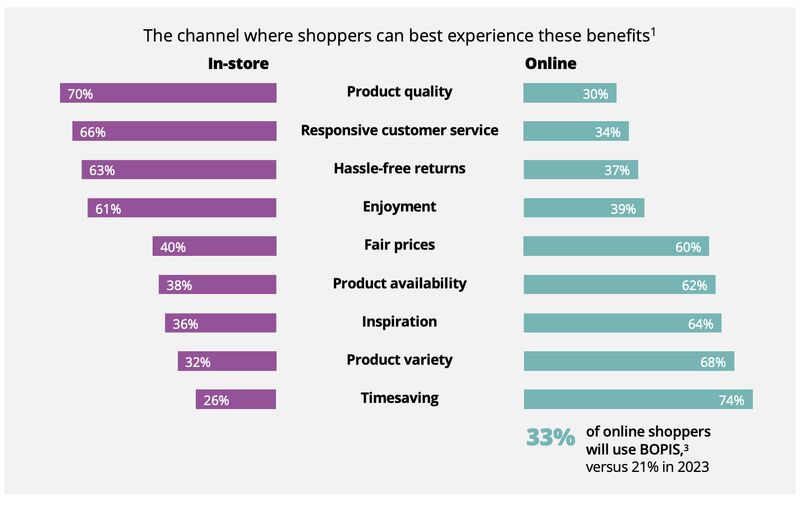
Source: Deloitte
6. Simplify the Shopping Experience through Shopping Guides & Checklists
Back-to-school season is hectic for shoppers, especially parents with multiple school children. Make it easy for them to breeze through shopping by providing guides or checklists. These help consumers know which products to buy and find items easily in-store.
For example, Target and Walmart have specific back-to-school supply lists personalized per school city or ZIP Code. As a small business, you can provide a particular category in your online store for back-to-school items or create a blog post with a downloadable checklist.
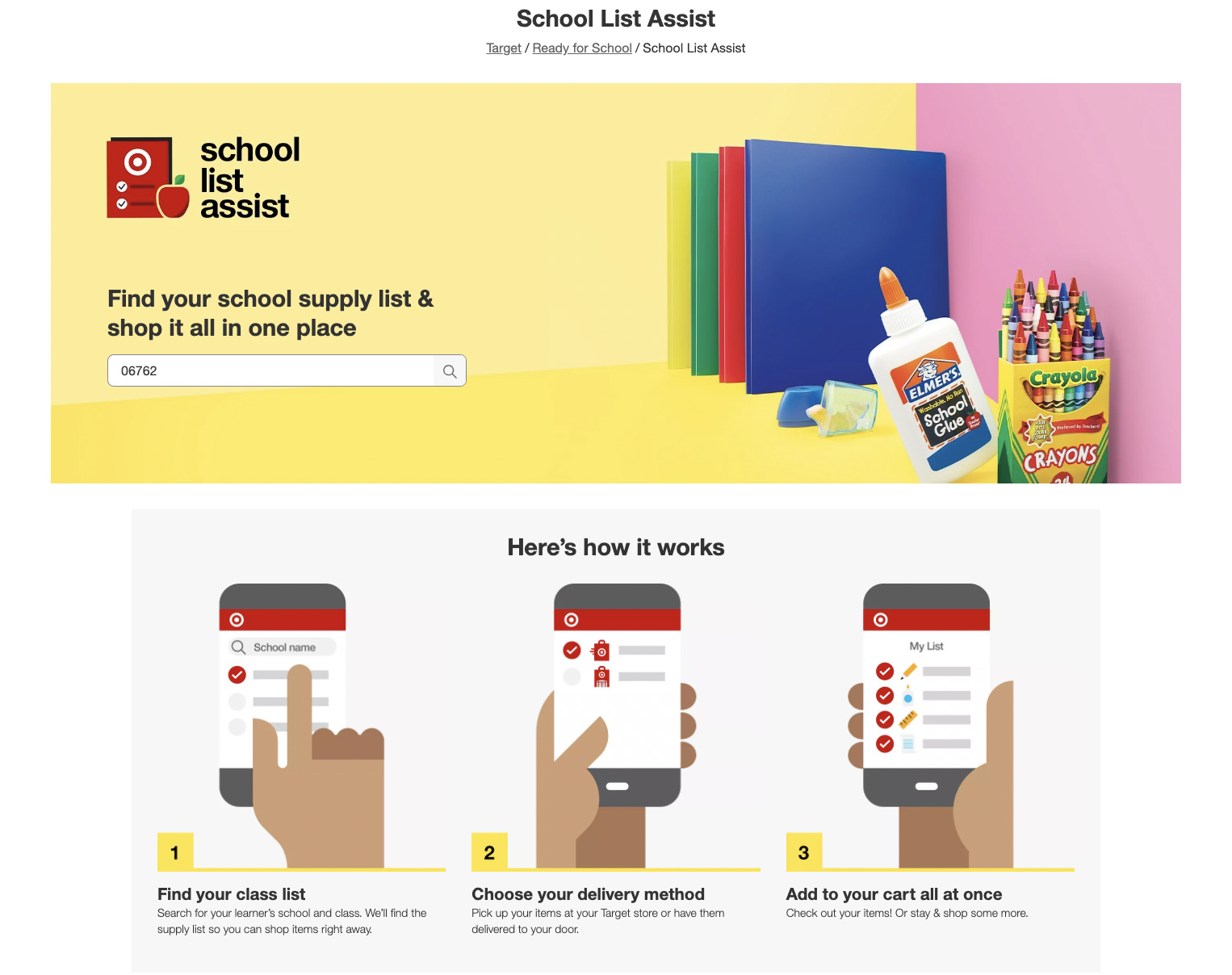
Target lets shoppers search for supply lists by ZIP Code, school, and classroom to purchase all supplies at once. Small retailers can work with local school districts to get supply lists and offer bundles for different grade levels or classrooms.
Target lets shoppers search for supply lists by ZIP Code, school, and classroom to purchase all supplies at once. Small retailers can work with local school districts to get supply lists and offer bundles for different grade levels or classrooms.
Better yet, have specific back-to-school bundles near your point-of-sale (POS), display them on your website’s homepage, or have a specific landing page for your back-to-school offerings.
7. Be Mobile-first
The recent NRF back-to-school retail trend report says consumers’ top destinations for back-to-school shopping are online (57%), department stores (50%), and discount stores (47%). What makes online shopping stand out is that the mobile version of your online store plays a huge role in converting sales.
As part of the omnichannel buying experience mentioned previously, consumers are now using their phones to make purchases, especially for last-minute needs, and even checking prices on other retailers’ websites while shopping in-store.
As retailers, you have opportunities to direct undecided shoppers to more profitable channels. So, start an online store for your brick-and-mortar shop if you haven’t yet.
It’s not enough to just have an online store, though. You also need to make sure that it is mobile-friendly. More people are choosing the convenience of shopping with their smartphones as they find it easier to research products and price comparisons using phone apps, allowing them to make a corresponding purchase.
Several top ecommerce platforms and WordPress shopping cart plugins make it easy to transform your webpage into a mobile-friendly ecommerce site. Implement ecommerce design tips, along with ecommerce marketing strategies, to increase your sales.
Along with our tips mentioned above, make sure all your back-to-school campaign ideas convert well into the mobile version of your website, too.
8. Do Your Marketing Online
Forty-six percent of shoppers are doing more comparative shopping online, wanting more time to research. Your deals must show up where people are looking—so try to implement some of these online marketing strategies:
Display Back-to-School Products on Special Webpages & Menus
Create unique back-to-school landing pages on your site to highlight back-to-school features, specials, and discounts. Also, try adding special back-to-school categories to your store menu to help buyers navigate the product types they want and shop quickly. Add prominent links to these special sections from your homepage and blog, and include them in email and social media marketing.
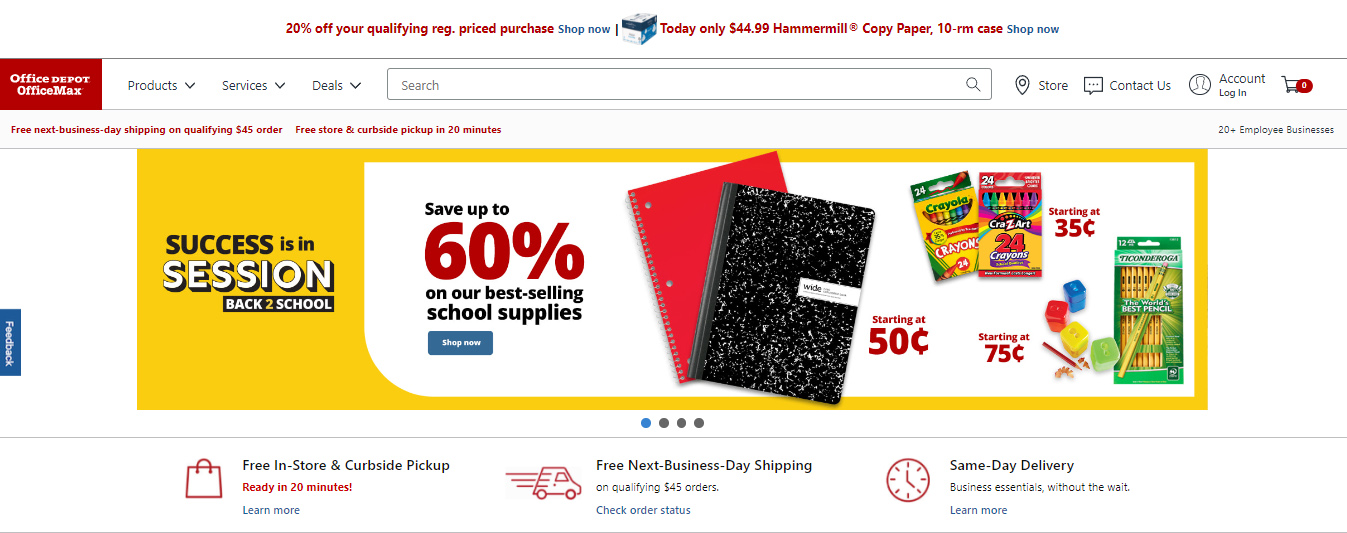
Office Depot’s back-to-school campaign is featured on its homepage, which also leads to a back-to-school section featuring popular deals.
Add Social Media to Your Marketing Strategy
According to Deloitte:
- One in three of back-to-school shoppers are social media users
- 78% use it for inspiration. They plan to use social media to browse products and read reviews/recommendations.
- 62% use it to find deals. They plan to use it to find a coupon code or learn about ongoing retail sales/promotions
Clearly, your social channels are ways to engage with customers, update them with the latest offerings, and show them how to use your products (through product photos or actual customer reviews—social proof).
Take a look at Walmart’s social media marketing strategy. They took advantage of reels and videos to showcase the newest back-to-school products available in-store.
View this post on Instagram
9. Create Smart Displays Using Strategic Product Layouts
Even with more than half of shoppers making their purchases online, don’t forget your brick-and-mortar shops!
Turn your power walls and other prime in-store real estate into back-to-school blowout displays that lure your customers in and entice them to buy. Maximize these key selling spots using tried-and-true retail store layout methods to keep your space organized and easy to navigate. Use must-buy back-to-school essentials to draw buyers in, allow ample room for movement on busy days, and keep your impulse-buy areas well stocked with inexpensive add-ons.
The back-to-school season is no different from other sale seasons. Implement retail marketing strategies to help boost sales.
10. Make It a Family Affair
Don’t just focus on the student who’s going back to school—include their parents, too, when strategizing your marketing for the season.
Deloitte’s latest study shows that despite the shift of focus to spending on necessities, 85% note that they could be influenced to splurge on a must-have item or if it will help their children get excited to go back to school.
Here are some tips to consider:
- Make your store child-friendly and appealing to kids. Sixty-one percent of parents say that their children influence them to spend more. If you can encourage parents to take their children shopping with them, there is a bigger chance of boosting your store’s sales.
- Don’t forget to entice parents to shop for themselves too. Fifty percent of those surveyed in the same Deloitte study said they plan to purchase something for themselves while shopping for their children, allowing you to secure more sales.
- Place promotions, bundles, and special offers in strategic places in your store, particularly near checkout (point-of-sale) to increase average order value and leverage impulse buying.
- Cross merchandise! Display items from different product categories together to incentivize multi-item purchases. For example, have family outfits on display that spark ideas for multiple-use outfits during school season (think PE days, athleisure, or family day events)
Read our articles to find more ideas:
- Visual Merchandising Strategies to Improve Your Store
- Tips & Ideas for Your Retail Store Window Displays
- Cross-selling Tips & Techniques for Retailers
- What Is Cross Merchandising? Techniques & Examples
- Effective POS Marketing Ideas for Driving Sales
11. Tap Into the Power of AI
The power of AI has not fully reached its potential in retail yet, but 18% of back-to-school shoppers plan to use generative AI for back-to-school shopping. The survey results are encouraging—most say AI enhances the shopping experience by letting them save time (35%), economizing (62%), and summarizing and looking for product reviews (76%).
Leverage AI for your marketing by employing tools to generate copy for social media, email, and even product descriptions. While there is nothing better than a human touch to inject some personality into your copy, using AI to generate a baseline of what you want to communicate with shoppers saves a lot of your time and energy—just make sure to edit heavily, if needed.
Read our free resources:
- AI in Retail: Small Business Guide
- Should You Use AI to Write Product Descriptions in 2024?
- Ways to Use AI for Small Business Marketing
- Ways to Use AI in Social Media (+ Examples)
12. Do Special Promotions for Education Personnel
When it comes to the back-to-school season, teachers need to prepare themselves as much as students, so retailers should not forget educators in their target market. However, unlike students, they might have different priorities and budgeting concerns that affect their buying decisions.
This allows retailers to differentiate themselves by giving special attention to teachers when offering discounts.
Here are some discount ideas you can try:
- Start a loyalty program that allows them to earn points for each dollar they spend; they can use them to save money on their next purchase
- Create a one-day exclusive sale for them during back-to-school season
- Offer them special discounts for customer referrals
Target does a great job with this by holding its yearly Teacher Prep Event where a 15% discount on select back-to-school items is offered at its stores.
13. Create Specific Back-to-School Campaigns for Your Business
Even if your retail business is not offering back-to-school-related items, you can still leverage the season to increase your sales. Here are some examples for specific industries:
Restaurants
If your restaurant offers a delivery service, consider providing special discounts for students and teachers around your area. You can hand out flyers near the schools or through short message service (SMS) marketing―sending promotions via text message. You should also consider creating an app that a young audience can easily download on their phones for free. Then, you can include marketing announcements and offer special event discounts directly to your subscribers.
Fitness Centers
Fitness centers and yoga studios can promote specific discounts, “buy 3, get 1 free” offers, or packages for specific time slots. This can be an enticing offer for parents who have the time while their kids are in school or for students and educators who can accommodate the slots into their schedules.
Salons & Barbershops
Parents and teachers want some time for themselves before or after the back-to-school rush. This makes for a perfect opportunity to provide special privileges they will appreciate. Consider offering back-to-school hair supply products as an incentive for purchasing services of a minimum particular dollar value. You can even have unique services like in-store childcare, makeover consultation, and others that will make shopping easier for your customers.
Frequently Asked Questions (FAQs)
Click through the sections below to get answers to the most often asked questions about back-to-school marketing.
Start as early as possible. Back-to-school shoppers shop as early as July, so start your campaigns at least three weeks before shopping season starts.
To effectively launch a back-to-school campaign for your store, set goals and objectives by reviewing last year’s sales performance and evaluating what were good and bad strategies. Monitor trends and incorporate them into your campaign. Plan ahead and be ready to pivot if initial data from the campaign isn’t that encouraging.
Go digital when it comes to advertising your back-to-school promotions. Most consumers now search online, particularly on social media, for sales and deals.
Bottom Line
Value, convenience, and sustainability are the emerging shopping themes I noticed in this year’s back-to-school trends reports. Capitalize on these trends by focusing on product value, cultivating loyalty, providing an omnichannel experience, leveraging social commerce and influencers, and making AI work for your business.